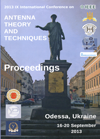Carbon nanotubes interference
DOI:
https://doi.org/10.1109/ICATT.2013.6650829Keywords:
CNT, antenna, Poklington, nanoantenna, analysis, CST Studio, HFSS, mutual resistance, current distributionAbstract
At present much attention is given to the scattering properties of the composite materials containing the incorporation of carbon nanotubes due to the prospects for their application to different branches of science and technology. To study successfully the structure and properties of such materials with the radio spectroscopy method it is essential to know their electrodynamical properties. In this case such structures are characterized by a sufficient complexity of their geometry (CNT location and orientation), and, as a result, by a complexity of their electrodynamical properties.
Interaction interference in the composite materials consisting of carbon nanotubes is considered in the report. Mutual resistance dependences on the carbon nanotubes distance and shift relative to each other in a wide frequency range are derived. The obtained results are discussed.
References
SLYUSAR V. Nanoantennas: approaches and prospects. ELECTRONICA: Nauka, Tekhnologyua Business, 2009, n.2, p.58-65.
MAKSIMENKO, S.A.; SLEPYAN, G.Y.; ET AL. Electromagnetic waves in carbon nanostructures. In: Carbon Nanotubes and Related Structures. Research Signpost Publisher, 2008 [ed. by V. Blank and B. Kulnitskiy], p.147-187.
HANSON, G.W. Fundamental transmitting properties of carbon nanotube antennas. IEEE Trans. AP, 2005, v.53, n.11. p.3426-3435, doi: http://dx.doi.org/10.1109/TAP.2005.858865.
LOH, K.J.; LYNCH, J.P.; KOTOV, N.A. Inductively coupled multifunctional carbon nanotube-based nanocomposite sensors. Proc. of Int. Symp. on Applied Electromagnetics & Mechanics, Lansing, MI, 2007.
GAVVA, D.C.; LUCHANINOV, A.I.; ET AL. Calculation of parameters of wire radiating structures of random configuration. Ch.10 in: Distance Methods and Means for Investigation of Processes in the Earth Atmosphere. Kharkov, 2002 [ed. by B.L. Kashcheev, E.G. Proshkin, M.F. Lagutin], p.399-425 [in Russian].
SLEPYAN, G.Y.; MAKSIMENKO, S.A.; LAKHTAKIA, A.; YEVTUSHENO, O.; GUSAKOV, A.V. Electrodynamics of carbon nanotubes: Dynamic conductivity, impedance boundary con ditions, and surface wave propagation, Phy. Rev. B, 1999, v.60, p.7136-17149, doi: http://dx.doi.org/10.1103/PhysRevB.60.17136.
WANG, Yue; WU, Yu-Ming; WU, Qun. Characteristics of radiation from zig-zag carbon nanotubes at terahertz range. Int. J. Wireless Microwave Technologies, 2009, n.1, p.52-59.
CST-Computer Simulation Technology-CST Studio Suite 2008. Ru eBook, 2008. 221 p.
BANKOV, S.E.; KURUSHIN, A.A. Raschet Antenn i SVCH Structur s Pomoschiu HFSS Ansoft. Moscow: RODNIK, 2009, 256 p.

